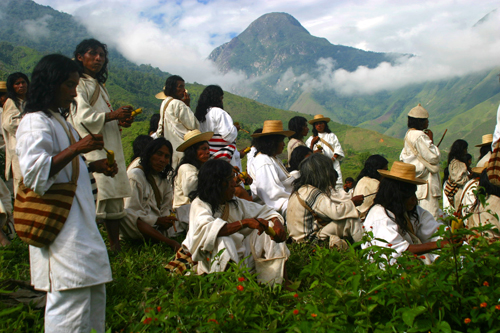Environment & Energy
Related: About this forumColombia to close popular Caribbean Park for natural protection
Colombia to close popular Caribbean Park for natural protection
English.news.cn 2015-10-29 13:38:19
BOGOTA, Oct. 28 (Xinhua) -- The Colombian authorities decided to temporarily close Tayrona National Nature Park, one of its most popular tourist destinations in the northern Caribbean region, in response to an indigenous community petition to protect nature.
The tourists ban takes effect on Nov. 1 and lasts one month.
The closure came after the indigenous community of Sierra Nevada of Santa Marta asked the authorities to close the park to revitalize the environment of Tayrona, a protected area with a diverse and rare
Tayrona Park, located a few kilometers east of Santa Marta city, covers approximately 30 square kilometers of maritime area in the Caribbean sea and approximately 150 square kilometers of land.
It boasts a variety of climate and geographical features, housing an extensive classification of animal species.
http://news.xinhuanet.com/english/2015-10/29/c_134762348.htm
(Short article, no more at link.)
[center] 
Local fauna - Tayrona Natural National Park, Colombia






 [/center]
[/center]
For the indigenous peoples living on the steep slopes of Colombia’s Sierra Nevada de Santa Marta, sustaining the balance of the spiritual and ecological world is their sacred task. They call themselves the Elder Brothers, the guardians of the Earth, and the rest of modern civilization are the Younger Brothers, whose exploitative practices are destroying the mountain’s ecosystem and, by extension, the rest of the planet. The four indigenous groups of this region—the Kogi, Wiwa, Arhuaco and Kankuamo—believe the Sierra Nevada de Santa Marta is the beating heart of the world: what happens here happens everywhere, and when its rivers run dry, its ice caps melt and its endemic species disappear, so do the rest of the world’s. They maintain their deep commitment to restoring equilibrium to the Earth through daily meditations, ritual practices and mental discipline, and they have continued this vigilance even as the Younger Brothers have encroached into the mountain with logging, mineral extraction, commercial plantations and drug-crop cultivation that placed them at the center of violence between warring factions in Colombia’s protracted civil war. Protecting the Sierra Nevada de Santa Marta’s water resources is now their focus, as they protest projects that will dam two mountain rivers and a massive ocean port development that will export natural resources mined in the region while also blocking access to a sacred site by the sea. In 2007, the four tribes issued a joint statement condemning the projects: “From the beginning of these projects we have expressed in many ways our opposition … They negatively affect our way of life, they degrade the environment, and they violate every part of the Constitution that pertains to the fundamental rights of our people.”
The Land and Its People The four existing indigenous tribes of the Sierra Nevada de Santa Marta are the remnants of a sophisticated pre-Hispanic civilization known as the Tayrona. When the first Spaniards set foot in Colombia in the 16th century, they found a civilization that practiced sustainable farming through crop rotation and vertical ecology, built terraced drainage systems that minimized erosion, and produced exceptional gold and pottery work. But the conquistadores drove the tribes high up into the mountain, where they tried to protect their culture through isolation. The Kogi were able to maintain the most traditional culture while the Wiwa and Arhuaco experienced different levels of acculturation. The Kankuamo, who had all but disappeared, are now working to recover their language and culture. Estimates for the total number of native people living in the Sierra Nevada de Santa Marta range between 35,000 and 51,000. Though the tribes speak different languages, they have nevertheless retained a common spiritual tradition. According to this tradition, when the great Mother created the world, she spun a spindle, and the threads that unspooled crossed to form the four Tayrona peoples and the Sierra Nevada de Santa Marta itself. Within the indigenous communities, every action and behavior is informed by what they call the “Law of Origin,” an ecological philosophy that governs their relationship to nature, animals, weather, bodies of water and the cycles of the planets and stars. The spiritual practices and ethical beliefs of the Tayrona revolve around their conception of aluna, which is the belief that all reality is created by thought, and that every object or being has both a physical reality and a spiritual essence, all originating in thought. The tribes’ highly trained ritual priests—the mamas—communicate in the aluna dimension through ritual and meditation. In their communion with the aluna world, the mamas focus on maintaining the ecological and spiritual equilibrium of the mountain. The Sierra Nevada de Santa Marta is a singular ecosystem. This multi-peaked volcanic massif, located just 25 miles inland from Colombia’s northeastern Caribbean coast and rising to a height of nearly 19,000 feet, is the world’s highest coastal mountain. Shaped like a pyramid—each side approximately 90 miles long—the mountain climbs through multiple ecological zones, from the wetlands and mangroves along the coast, through tropical rain forests, deserts and alpine tundra, until finally reaching the snow-capped peaks. Thousands of plant and hundreds of animal species, dozens of which are endemic, have been found here, including 628 bird species—about equal to what has been identified in the United States and Canada combined. The Sierra Nevada de Santa Marta is drained by more than 30 rivers, which makes it an invaluable water source for the 1.5 million people who live in the cities and towns that circle the base of the mountain. It is this rich water resource that is now threatened by the multiple dam and irrigation projects currently under way.
- See more at: http://www.sacredland.org/sierra-nevada-de-santa-marta/trackback/#sthash.CfDmeSQM.dpuf